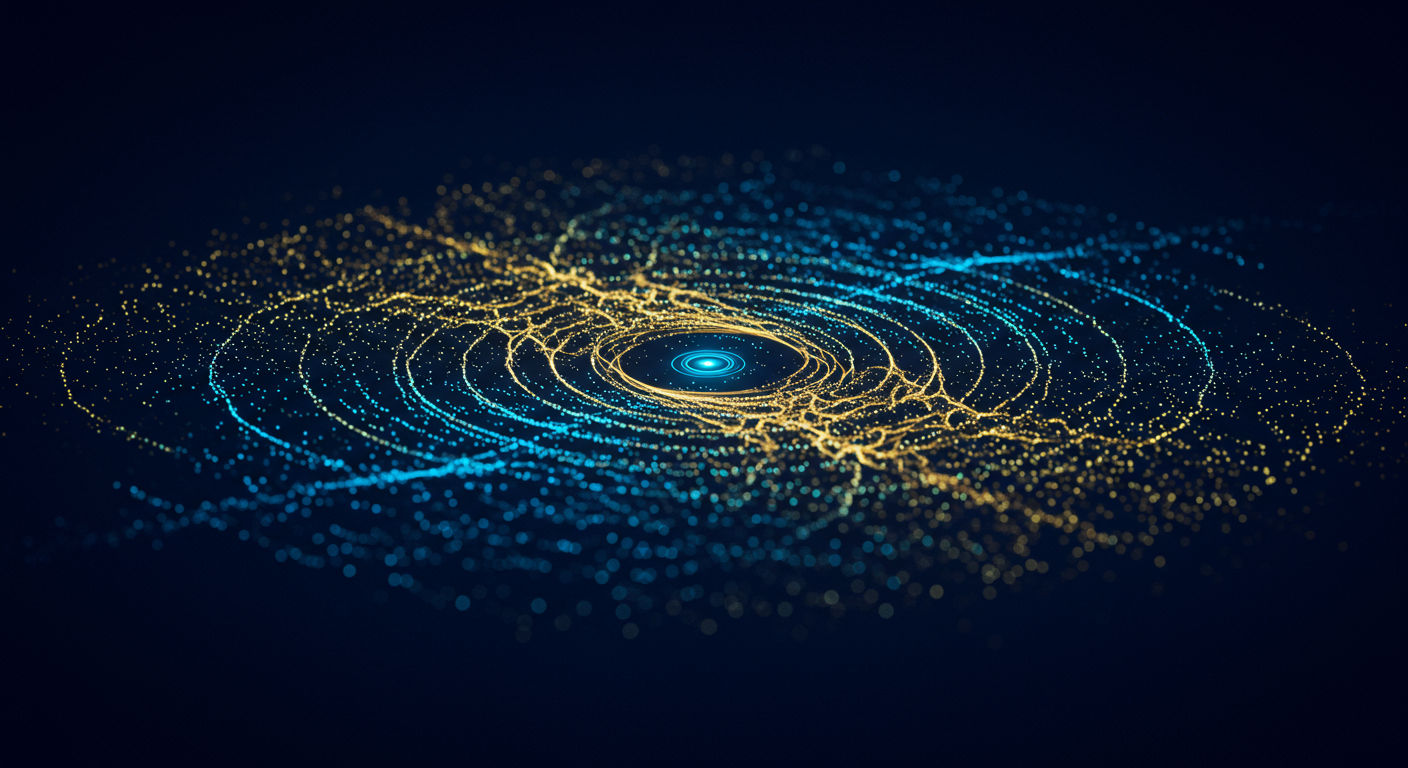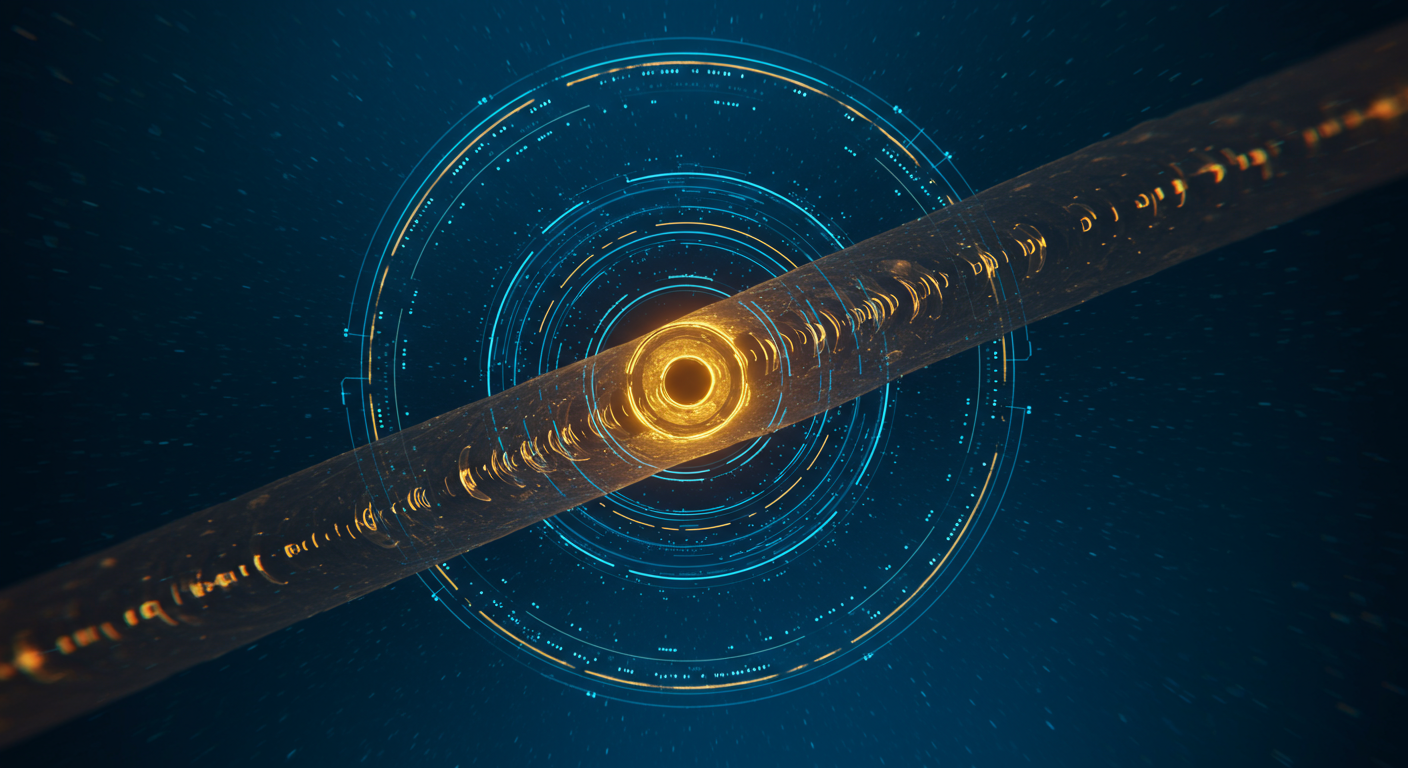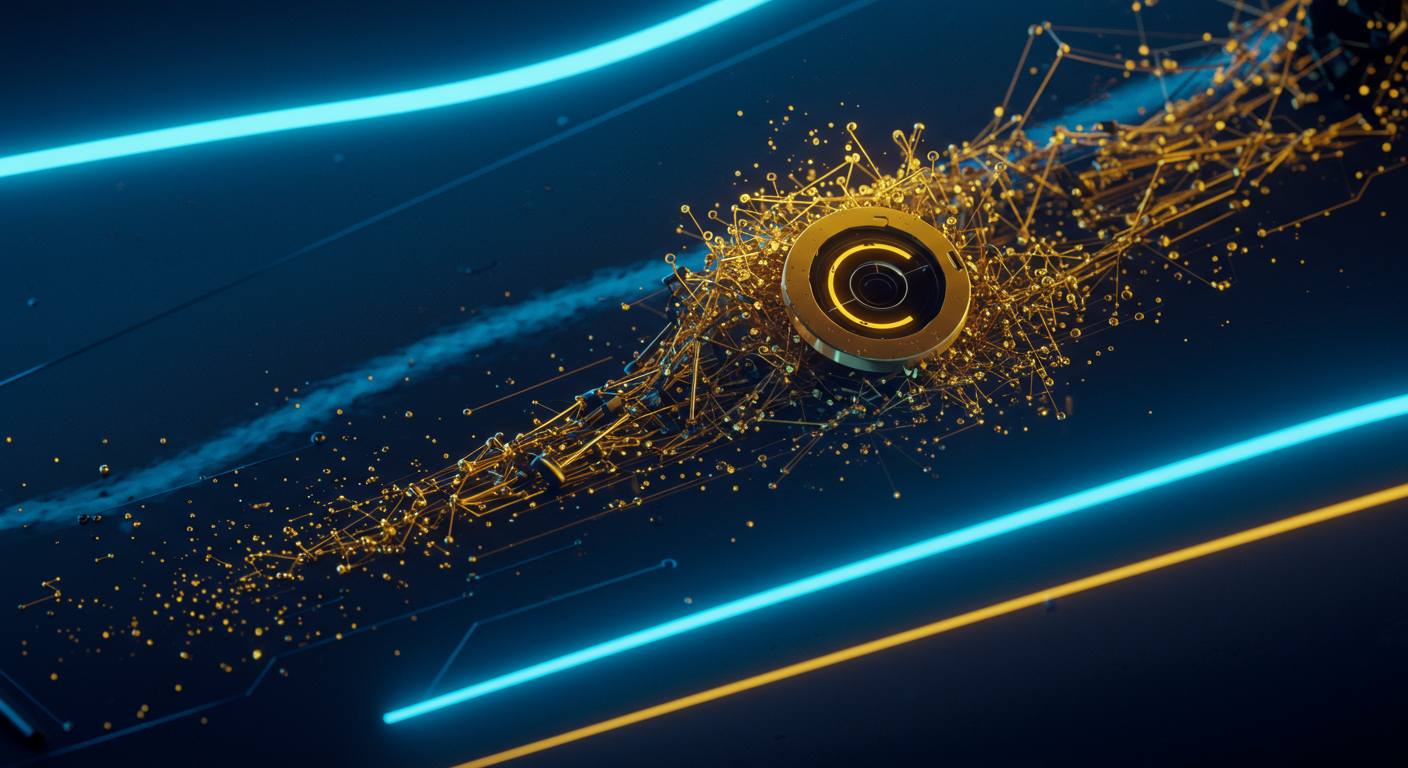Quantum State Evolution with QuTiP: A Coder's Guide to Decoherence and Entanglement

Unveiling Quantum Mysteries: A Practical Guide to State Evolution, Decoherence, and Entanglement with QuTiP
Prepare to delve into the fascinating world of quantum mechanics, where superposition and entanglement reign supreme, shaping the future of quantum computing and information.
Quantum Essentials: A Crash Course

Quantum state evolution, decoherence, and entanglement are fundamental concepts:
- Quantum State Evolution: Describes how quantum states change over time, governed by the Schrödinger equation. Think of it as the quantum equivalent of tracking a billiard ball's trajectory, but with probabilities and wave functions.
- Decoherence: Explains how quantum systems lose their "quantumness" due to interactions with the environment, essentially becoming classical. Imagine a delicate quantum state being "smudged" by external noise.
- Entanglement: A bizarre phenomenon where two or more particles become linked, regardless of distance. Change the state of one, and the other instantly reflects the change. Spooky action at a distance, indeed.
QuTiP: Your Quantum Toolkit
This article serves as a hands-on guide to simulating these quantum phenomena using QuTiP, the Quantum Toolbox in Python.
QuTiP makes quantum mechanics accessible to both beginners and seasoned researchers.
Python's versatility combined with QuTiP's intuitive framework allows you to model complex quantum systems with relative ease.
Common Misconceptions Busted
Many find quantum mechanics perplexing. No, your cat isn't really both dead and alive (Schrödinger's cat is a thought experiment!). We'll tackle these head-on, providing clear explanations and practical simulations.Ready to explore the quantum realm? Stay tuned as we unravel these mysteries one Python script at a time.
Hold on to your qubits, because we're about to dive into the fascinating world of quantum computing with Python!
QuTiP 101: Setting Up Your Quantum Laboratory in Python
QuTiP, or Quantum Toolbox in Python, is your go-to for simulating quantum systems. Think of it as your personal quantum playground.
Installation: Your First Step into the Quantum Realm
Installation is surprisingly straightforward. Open your terminal and type:
bash
pip install qutip
Core Data Structures: Qobj
At the heart of QuTiP lies the Qobj (Quantum Object).
- Think of it as QuTiP’s equivalent of a NumPy array, but specifically designed for quantum states and operators.
- A
Qobjcan represent a quantum state (like a qubit) or a quantum operator (like a Pauli matrix). - It has attributes like
shape(dimensions of the matrix) anddims(hierarchical structure for composite systems).
Creating Quantum States: Hello, Quantum World!
Let's create some basic quantum states:
-
|0>(ground state):basis(2, 0) -
|1>(excited state):basis(2, 1) - Superposition state:
(basis(2,0) + basis(2,1)).unit()(normalized)
state.norm() to get the norm, and state.unit() to normalize.Defining Quantum Operators: The Pauli Gang
Quantum operators act on quantum states. Let’s define the Pauli matrices:
| Operator | QuTiP Code |
|---|---|
| Pauli X | sigmax() |
| Pauli Y | sigmay() |
| Pauli Z | sigmaz() |
Basic Operations: Quantum Math
You can perform addition, subtraction, multiplication, and adjoint operations on Qobjs.
Example:
H = (sigmax() + sigmaz()) / np.sqrt(2)creates a Hadamard gate.
Best Practices: Quantum Zen
- Use sparse matrices whenever possible for memory efficiency.
- Leverage QuTiP's built-in functions for common operations.
- Always check for normalization of states.
It's not just about predicting the future anymore; we're simulating it, one quantum state at a time.
Simulating Quantum State Evolution: Schrodinger and Beyond
Here's a coder's dive into simulating the evolution of quantum states, with a bit of QuTiP magic sprinkled in.
The Schrodinger Equation: Quantum's Clock
At the heart of quantum mechanics lies the time-dependent Schrödinger equation, acting as the ultimate guide for understanding how quantum states morph over time. Think of it as a cosmic choreographer, dictating the dance of probability amplitudes. More formally:iħ ∂Ψ/∂t = HΨ
Where:
- i is the imaginary unit
- ħ is the reduced Planck constant
- Ψ is the wave function (quantum state)
- H is the Hamiltonian operator
QuTiP's mesolve: Your Quantum Time Machine
QuTiP – Quantum Toolbox in Python – offers the mesolve function, a powerful tool that solves the Schrödinger equation for a variety of quantum systems. Imagine using it to model a qubit buzzing in a magnetic field or simulating the intricate interactions of trapped ions.
- Example:
mesolve(H, psi0, tlist, c_ops, e_ops)will evolve an initial statepsi0under the HamiltonianHover a timespantlist.
Visualizing the Quantum Leap
What's the point of all that computation if you can't see what's happening? QuTiP allows us to chart the time evolution of quantum states using Bloch sphere animations, revealing the intricate trajectories of qubits.Real-World Limitations & Decoherence
In the real world, quantum systems aren't isolated. Interactions with the environment lead to decoherence, which the Schrödinger equation can't fully describe.- Enter the Lindblad Master Equation: This takes into account energy dissipation, for a more realistic picture.
Looking Ahead
Simulating quantum systems lets scientists explore everything from materials science to developing quantum Software Developer Tools with unprecedented accuracy. Consider it the ultimate playground for testing new ideas. Understanding these fundamental principles opens doors to manipulating the [time evolution operator QuTiP] with increasing control and fidelity.The universe of quantum computing can seem pristine, but decoherence – the loss of quantum information to the environment – throws a wrench in the gears.
Taming Decoherence: Modeling Open Quantum Systems with QuTiP
What is Decoherence, Anyway?
Decoherence is a quantum state's gradual loss of coherence, turning quantum weirdness into classical predictability. Imagine a perfectly tuned guitar string suddenly exposed to a noisy concert – that's decoherence in action. Common sources include:
- Thermal Noise: Erratic heat energy jostling quantum systems.
- Electromagnetic Radiation: Stray photons interacting with qubits.
- Material Imperfections: Flaws within the physical qubits themselves.
The Lindblad Master Equation: A Modeler's Best Friend
Enter the Lindblad Master Equation, a powerful tool to simulate decoherence's effects. It mathematically describes how an open quantum system – one interacting with its environment – evolves over time. Forget Schrödinger's equation for isolated systems; Lindblad handles the messy real world!
QuTiP to the Rescue: Simulating Decoherence
QuTiP provides Python tools to simulate quantum systems. Specifically, we leverage mesolve with "collapse operators" – mathematical representations of decoherence processes.
- Amplitude Damping: Qubits spontaneously decay to their ground state. Think of it like a leaky bucket; the quantum information drains away.
- Dephasing: Qubit superposition states lose their phase relationship. It's like a blurry image; the quantum signal becomes smeared.
QuTiP Lindblad operators that simulate amplitude damping with L = np.sqrt(gamma) * sigma_m, where gamma is the decay rate and sigma_m is the lowering operator.Visualizing the Quantum Fade
Decoherence is more than just numbers; it's a visual phenomenon! By plotting quantum states on the Bloch sphere, you'll witness the effects firsthand:
Watch as the coherent quantum state spirals inward towards the sphere's pole, losing its sharpness as decoherence takes hold!
Mitigating the Inevitable
While decoherence is a formidable foe, it's not unconquerable! Strategies like quantum error correction aim to protect quantum information from environmental noise, paving the way for robust quantum computers.
By understanding and modeling decoherence with tools like QuTiP, we can design more resilient quantum systems and push the boundaries of what's possible.
Harnessing quantum entanglement is no longer confined to theoretical musings; we can simulate and visualize its behavior with tools like QuTiP.
Quantum Entanglement Unveiled
Quantum entanglement, at its core, is a correlation between quantum systems that transcends classical understanding, making it vital for quantum computing and communication. It’s like having two coins that always land on opposite sides, regardless of the distance separating them – spooky action at a distance, as my predecessor might say.Entanglement in Action with QuTiP
Using QuTiP, a Python library for quantum mechanics, creating entangled states becomes straightforward:- Creating Bell States: These are fundamental entangled states, and QuTiP allows you to generate them with just a few lines of code.
- Simulating Dynamics: Observe how entangled states evolve, especially when subjected to decoherence—the bane of quantum systems!
- Measurement: Employ QuTiP’s functions to quantify entanglement using metrics like Concurrence QuTiP, which measures the degree of entanglement between two qubits.
Visualizing and Applying Entanglement
QuTiP offers various visualization techniques, from density matrices to more abstract representations, making entanglement tangible. You can even simulate quantum teleportation protocols, demonstrating practical applications of this mind-bending phenomenon. For those seeking coding assistance, consider checking out Code Assistance AI Tools to streamline your development process."Entanglement is not just a tool; it's a glimpse into the interconnectedness of reality itself."
We've only scratched the surface of entanglement dynamics, but with QuTiP, you're well-equipped to explore further and perhaps stumble upon the next breakthrough in quantum technology. Now, let's delve into more practical applications of AI...
Alright, buckle up buttercups, because things are about to get quantum!
Advanced Techniques: Beyond the Basics with QuTiP
QuTiP isn't just for simulating basic quantum systems; let's crank up the complexity!
Quantum Trajectories with Monte Carlo
Want to see a quantum system "evolve" under measurement? Use the Monte Carlo trajectory method. It's like watching a single atom dance under a laser pointer. QuTiP lets you implement these quantum trajectories with ease. The QuTiP library helps you easily implement quantum trajectories, giving you insights into how quantum systems evolve in time when subjected to external influences.
- The
mcsolvefunction is your friend here. - Feed it your Hamiltonian, initial state, and operators describing the system.
- Visualize individual quantum "paths," revealing how measurement affects evolution.
Quantum Control Simulations
Ever dreamt of controlling a qubit with laser pulses? QuTiP lets you simulate quantum control experiments. You can model the interaction of quantum systems with external fields, optimizing pulse shapes for specific quantum tasks.
This involves defining time-dependent Hamiltonians and using QuTiP's solver functions to see how different control pulses affect the system's evolution.
Implementing Quantum Algorithms
Ready to code your own quantum algorithms? QuTiP makes it possible! Implementing algorithms with QuTiP gives you hands-on experience with concepts like superposition and entanglement.
- Try the Deutsch-Jozsa algorithm as a starting point.
- It's a simple, yet elegant, demonstration of quantum speedup.
- Experiment with larger, more complex algorithms as your skills grow.
Supercharging Performance with Parallelization
Quantum simulations can be computationally intensive. Luckily, you can leverage parallel processing within QuTiP to speed things up. This means more cores working together, and therefore, faster results!
Integrating with the Scientific Ecosystem
QuTiP plays nicely with other scientific powerhouses like NumPy, SciPy, and pandas. Integrating QuTiP with these libraries allows for advanced data analysis and visualization.
| Library | Use Case |
|---|---|
| NumPy | Array operations, numerical computation |
| SciPy | Optimization, special functions |
| Pandas | Data analysis, tabular data manipulation |
Analyzing the Results
Once you've run your simulations, you need to make sense of the data. Learn how to use pandas to efficiently analyze numerical data generated by QuTiP. This involves processing large datasets, performing statistical analyses, and creating insightful visualizations.
Knowing the Limits
QuTiP is powerful, but not perfect. It's important to understand its limitations, such as memory usage for large systems, and explore potential improvements for the library itself. By understanding the limitations, you can use QuTiP more effectively, and maybe even contribute to improving it!
So, there you have it – a sneak peek into advanced QuTiP techniques. Now go forth and simulate some quantum magic! And next time, we'll explore more tools for Scientific Research.
Quantum Horizons: Future Directions and Research Opportunities with QuTiP
The real fun starts when we look towards the uncharted waters where quantum computing and simulation are headed.
Pushing the Boundaries of Quantum Simulation
Quantum computing is racing ahead, and tools like QuTiP are vital for simulating quantum systems and paving the way for real-world applications. Think of it as a digital sandbox where you can model quantum phenomena that are too complex for classical computers. Recent research trends include:
- Exploring novel quantum materials: Using QuTiP to simulate the behavior of exotic materials could lead to breakthroughs in energy storage and superconductivity.
- Improving quantum error correction: Quantum computers are notoriously sensitive to noise, so simulating error correction codes is key.
- Developing quantum algorithms: QuTiP can be used to test and refine new algorithms before they're run on actual quantum hardware.
Open Questions and Unexplored Territory
QuTiP offers a powerful platform for addressing fundamental questions in quantum physics.
“The only way to discover the limits of the possible is to go beyond them into the impossible.” – Arthur C. Clarke (kinda sums it up, right?)
Consider these potential projects using QuTiP:
- Simulating open quantum systems to study decoherence effects.
- Investigating the dynamics of entanglement in multi-particle systems.
- Exploring the interplay between quantum mechanics and thermodynamics.
Join the QuTiP Community

The QuTiP community is vibrant and welcoming, offering support and resources for both beginners and experienced users. Contributing to open-source projects like this is a fantastic way to learn and build your skills, plus you can check out other tools in our AI tool directory. Contributing is easy, whether submitting bug fixes, improving documentation or sharing your own simulation code.
Want to delve deeper? Check out the official QuTiP documentation and explore relevant research papers on arXiv. Other quantum simulation software, like Qiskit and Cirq, offer alternative approaches, so check out comparisons to see what best fits your needs.
With QuTiP, you're not just writing code, you're helping to shape the future of quantum technology, so, why not dive in and leave your imprint on the quantum realm?
Keywords
Quantum State Evolution, Quantum Decoherence, Quantum Entanglement, QuTiP, Python Quantum Computing, Quantum Simulation, Density Matrix, Bloch Sphere, Quantum Dynamics, Open Quantum Systems, Quantum Measurement, Monte Carlo Trajectories
Hashtags
#QuantumComputing #QuTiP #QuantumPhysics #AIinScience #Entanglement
Recommended AI tools
ChatGPT
Conversational AI
AI research, productivity, and conversation—smarter thinking, deeper insights.
Sora
Video Generation
Create stunning, realistic videos and audio from text, images, or video—remix and collaborate with Sora, OpenAI’s advanced generative video app.
Google Gemini
Conversational AI
Your everyday Google AI assistant for creativity, research, and productivity
Perplexity
Search & Discovery
Clear answers from reliable sources, powered by AI.
DeepSeek
Conversational AI
Efficient open-weight AI models for advanced reasoning and research
Freepik AI Image Generator
Image Generation
Generate on-brand AI images from text, sketches, or photos—fast, realistic, and ready for commercial use.
About the Author

Written by
Dr. William Bobos
Dr. William Bobos (known as 'Dr. Bob') is a long-time AI expert focused on practical evaluations of AI tools and frameworks. He frequently tests new releases, reads academic papers, and tracks industry news to translate breakthroughs into real-world use. At Best AI Tools, he curates clear, actionable insights for builders, researchers, and decision-makers.
More from Dr.

